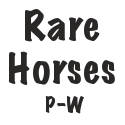 Sadly there is a great big variety of horse breeds that are considered rare – some in more danger than others. In the spirit of educating the public, I’m hoping to share as many of them as I can & spread awareness.
Sadly there is a great big variety of horse breeds that are considered rare – some in more danger than others. In the spirit of educating the public, I’m hoping to share as many of them as I can & spread awareness.
The fourth installment of rare equine breeds, this is the last of the alphabet – until I learn about more. This addition is dedicated to Przewalski’s Horse (the last of the true wild horses) all the way to the handsome Welsh Cob.
Breeds You Don’t See Everyday
Build – A large, rough and primitive head with a short stocky body.
Nature – Extinct in the wild, these horses are preserved in captivity but rarely are they broken and ridden. Their blood has long been wild and they make an unruly mount.
Colors – Dun, often with a mealy gene
Origin – One of the prehistoric breeds, cave paintings in both Europe and Asia show their likeness. Population growth and development has continued to push this breed into fewer and fewer numbers until their extinction as a wild animal.
More information – Przewalski’s Horse
Build – Built straight to accommodate its gaited movements, sloping 45 degree shoulder and well shaped ears.
Nature – Gentle, strong, versatile and eager to please.
Colors – Solid body color with no white above the knee or hock, black, bay, chestnut and silver dapple, their signature color.
Origin – Very little documentation follows this breed during most of the 20th century. It is known that the breed originated in the Appalachian mountains of eastern Kentucky. Bred as versatile saddle horses, poor and hard conditions created a inbred strength in the Rocky Mountain.
More information – Rocky Mountain Horse
Build – Built for heavy work, the shire is large and muscular, with a long, lean head, a deep shoulder, large girth, a short strong back, good leg joints and feet. One of the largest modern draft breeds on the planet.
Nature – Large and friendly, the shire is tough, willing and eager to please.
Colors – Black, bay, chestnut, grey are standard colors, excessive white and roaning is discouraged.
Origin – Descendants of the medieval Great Horse brought to England early in the 11th century. As industry advanced horses were replaced with heavy machinery which caused the Shire’s numbers to dwindle. Now their blood is used to enhance hunters and jumpers.
More information – Shire
Build – Long legs, and convex iberian profile, long ears, slender neck, medium back, deep, narrow chest, hard hooves.
Nature – Evolved to survive under adverse conditions, they can withstand extreme temperatures and low quality food. They are agile and eager to please.
Colors – Always dun with primitive markings, purebloods have no white markings on them.
Origin – An ancestor of the mighty Andalusian and Lusitano, their likeness is documented in prehistoric cave art. They were officially discovered by a Portuguese scientist in 1920 and they are named after the location (Sorraia) where they were found. The Sorraia is very nearly extinct today, and are kept alive in Portugal and Germany.
More information – Sorraia
Build – A medium sized horse, well proportioned with short back, round hindquarters, deep girth, short, pointed ears, convex nose, and a crested neck.
Nature – Tough and full of fire, these horses have evolved in the wild for thousands of years. They become very attached to those who handle them, but possess a strong and stubborn spirit.
Colors – Can be found in almost any color or white pattern.
Origin – Originally brought to the New World by the Spanish Conquistadors where breeding farms were established in the Caribbean and Mexico. Native Americans prized these animals which helped to spread them north.
More information – Spanish Mustang Registry, Inc.
Build – Large horses that are very uniform in body type. Built for hard farm work Suffolks are short and thick, charactorized by short, muscular legs with good feet and an arched neck.
Nature – Willing and able with a great deal of tenacity and endurance.
Colors – Chestnut, from light golden to dark liver. Pure bred animals can only be chestnut.
Origin – The oldest draft breed in Great Britain and their ancestry dates back to the 16th century. Numbers declined as technology removed the practical need for them. (in 1966 only 9 Suffolk foals were born).
More information – Suffolk Punch
Build – Compact and built for work with a muscular body, stout limbs, heavy head with straight profile.
Nature – Docile and kind
Colors – Black, bay, chestnut, grey or roan
Origin – Bloodlines from Ardennes horses imported into Sweden from Belgium in the 19th century. Like other draft breeds its numbers diminished as technology rose.
More information – Swedish Ardennes
Build – Gaited horse with Spanish conformation characteristics
Nature – High stepping and lively, these horses are built to cover long distances as an efficient and high-energy gait. They are willing and energetic.
Colors – Appaloosa (leopard complex).
Origin – Bred by Native American tribes in North America, who attempted to keep the bloodlines pure. Their genetic roots owe much of their blood to Spanish animals.
More information – Tiger Horse
Build – Bright eyes, strong shoulder, dense hooves and powerful hocks. Built for a high stepping gait and driving purposes.
Nature – Gentle, but strong and active, this small horse is hardy, quite powerful and adores people.
Colors – Black, grey, bay, roan, cream or chestnut. Piebald and skewbald is discouraged.
Origin – Originally used to carry British Knights in the 15th century, they would lead the larger battle horses into the fight.
More information – Welsh Cob
Tahnks for posting
very interesting thanks for putting this here